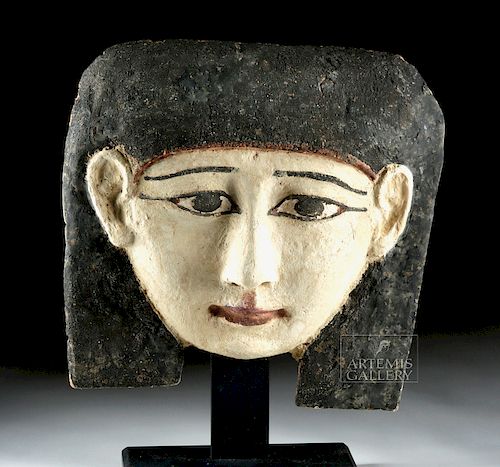Egyptian Late Dynastic Painted Cedar Sarcophagus Mask
Lot 7
About Seller
Artemis Fine Arts
686 S Taylor Ave, Ste 106
Louisville, CO 80027
United States
Selling antiquities, ancient and ethnographic art online since 1993, Artemis Gallery specializes in Classical Antiquities (Egyptian, Greek, Roman, Near Eastern), Asian, Pre-Columbian, African / Tribal / Oceanographic art. Our extensive inventory includes pottery, stone, metal, wood, glass and textil...Read more
Estimate:
$12,000 - $15,000
Absentee vs Live bid
Two ways to bid:
- Leave a max absentee bid and the platform will bid on your behalf up to your maximum bid during the live auction.
- Bid live during the auction and your bids will be submitted real-time to the auctioneer.
Bid Increments
| Price | Bid Increment |
|---|---|
| $0 | $25 |
| $300 | $50 |
| $1,000 | $100 |
| $2,000 | $250 |
| $5,000 | $500 |
| $10,000 | $1,000 |
| $20,000 | $2,500 |
| $50,000 | $5,000 |
| $100,000 | $10,000 |
| $200,000 | $20,000 |
About Auction
By Artemis Fine Arts
Feb 21, 2019
Set Reminder
2019-02-21 10:00:00
2019-02-21 10:00:00
America/New_York
Bidsquare
Bidsquare : Exceptional Antiquities, Asian, Ethnographic
https://www.bidsquare.com/auctions/artemis-gallery/exceptional-antiquities-asian-ethnographic-3858
An important one-day auction featuring museum-worthy examples of Egyptian, Greek, Roman, Etruscan, Near Eastern, Far East / Asian, Pre-Columbian, African / Tribal, Oceanic, Native American, Spanish Colonial, Russian, Fossils, Ancient Jewelry, Fine Art, so much more! Artemis Fine Arts info@artemisfinearts.com
An important one-day auction featuring museum-worthy examples of Egyptian, Greek, Roman, Etruscan, Near Eastern, Far East / Asian, Pre-Columbian, African / Tribal, Oceanic, Native American, Spanish Colonial, Russian, Fossils, Ancient Jewelry, Fine Art, so much more! Artemis Fine Arts info@artemisfinearts.com
- Lot Description
Egypt, Late Dynastic Period, 26th to 31st Dynasty, ca. 664 to 332 BCE. A striking example of a sarcophagus mask, hand-carved from wheat-hued cedar, with painted details in white, red, and black hues that emphasize the remarkably human countenance. The expressive female visage is defined by huge almond-shaped eyes with elongated corners beneath thin brows, a prominent nose of naturalistic form with delineated nostrils, lightly-rounded cheeks, pouty lips with indented corners, and cupped ears, all set within the folds of the black-painted tripartite wig. The face is painted with pale-yellow pigment which accentuates the white eyes, black pupils and brows, and red lips, and a slender strip of red delineates the forehead from the wig. A few large dowel holes along the verso still contain remnants of the original dowels used to attach the mask to a larger sarcophagus. Custom museum-quality display stand included. Size: 12.5" W x 13.375" H (31.8 cm x 34 cm); 15.375" H (39.1 cm) on included custom stand.
Ancient Egyptians believed it was of the utmost importance to preserve a body of the deceased, because the soul needed a place to reside after the death. Preservation of the body was done via mummification - a process involving the removal of internal organs that were placed in canopic jars, wrapping body in linen, and then embalming. Death masks like this example were created so that the soul could recognize the body and return to it. For this reason, death masks were made in the relative likeness of the deceased.
This mask and others like it were traditionally carved from cedar. Interestingly, cedar wood was not native to Egypt. Egypt did not have verdant forests filled with tall trees, and unfortunately most of its native lumber was of relatively poor quality. Thus, they relied on importing to acquire hardwoods - ebony imported from Africa, cedar and pine from Lebanon. One fabulous obelisk inscription by Thutmose III attests to the luxury of treasured hardwoods. It reads as follows, "They brought to me the choicest products . . . consisting of cedar, juniper and of meru wood . . . all the good sweet woods of God's Land." The rarity of cedar meant that masks like this one were reserved for those who could afford them.
Provenance: private East Coast, USA collection; ex-private Goldberg estate collection; ex-private Simonian collection, California, USA, collected in the 1960s and acquired by previous owner via descent
All items legal to buy/sell under U.S. Statute covering cultural patrimony Code 2600, CHAPTER 14, and are guaranteed to be as described or your money back.
A Certificate of Authenticity will accompany all winning bids.
We ship worldwide and handle all shipping in-house for your convenience.
#143569Restoration to verso of wig flaps, small repair to bottom of verso, with overpainting along break lines as well as across face and wig. Minor nicks and abrasions to eyes, nose, mouth, and headdress, with fading to areas of original pigmentation, and light encrustations. Light earthen deposits and fabulous traces of original pigmentation throughout.Condition
- Shipping Info
-
All shipping is handled in-house for your convenience. Your invoice from Artemis Gallery will include shipping calculation instructions. If in doubt, please inquire BEFORE bidding for estimated shipping costs for individual items.
-
- Buyer's Premium



 EUR
EUR CAD
CAD AUD
AUD GBP
GBP MXN
MXN HKD
HKD CNY
CNY MYR
MYR SEK
SEK SGD
SGD CHF
CHF THB
THB














